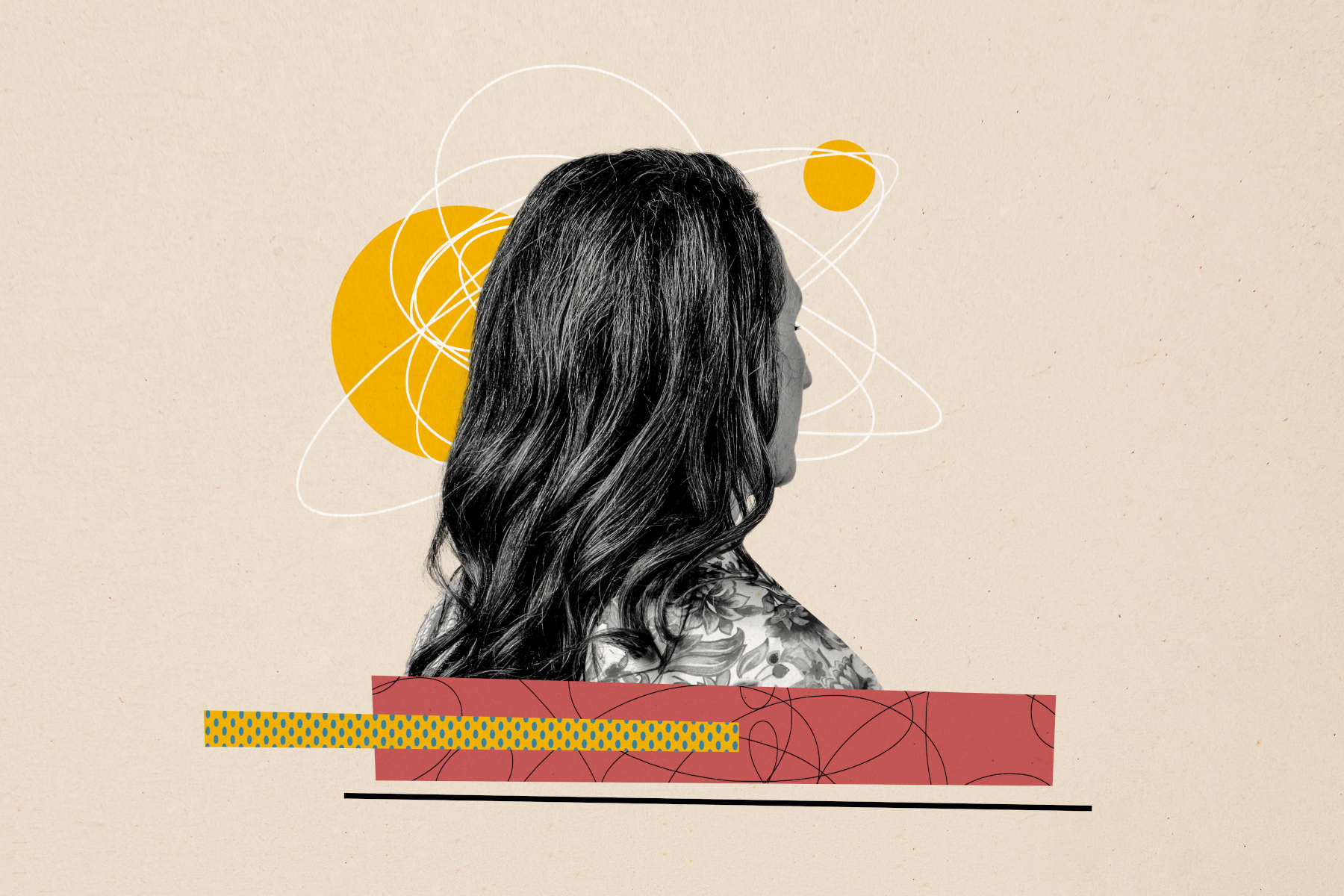
In September 2021, my son, Max, started kindergarten. I was nervous for him, as most parents would be. But I was also nervous for myself. I had recently bought a mobility scooter because I couldn’t rely on my chronically aching knees to make it half a block up the street to my kids’ school. I was worried about the questions and the stares I would get as people tried to figure out “What’s wrong with her?” I was unsure how I would navigate the narrow city sidewalks that would be full of kids, parents, caregivers, and strollers. I was afraid it would rain; my scooter cannot get wet, so if the weather called for it, I might miss out on this rite of passage. I was upset that taking my kid to school felt so complicated.
When the day came, the forecast was clear, so we set off up the street. The goodbye was hard. Max was afraid and didn’t want to leave me, having been at home with me since he was born. I wasn’t sure how long to linger, if I was helping him or making it harder for him, and I felt so in the way, sitting on my scooter, blocking a good portion of the sidewalk.
When my husband and I finally tore ourselves away, I started to cry. I cried for my little guy, who looked so small standing alone in the schoolyard, dwarfed by his dinosaur backpack, while other kids played around him. I also cried for myself. I felt like I had failed my son by not better preparing him for this moment. I felt guilty because he didn’t go to daycare or preschool, in part because of my physical limitations. I was also facing the prospect of being stuck on that scooter for the rest of the school year and, potentially, forever.
This difficult day was just one in a series of difficult days I’ve had because I live with chronic pain. Over the past twenty years, I have had to navigate one form of pain after another—constant swelling in my right knee due to seronegative arthritis, back soreness and tension headaches, dull but persistent aches in my arms and shoulders, tightness in my jaw, and abdominal issues that had me doubled over.
When my now nine-year-old daughter was a toddler, there were times I couldn’t tuck her into bed because I was in too much pain to climb the stairs to her bedroom. She would kiss me through the railing as my husband took her up—stair kisses, we called them—and I would stay downstairs by myself. Pain has prevented me from going to the zoo and Canada’s Wonderland and even to the local park. It’s affected the amount of work I have been able to take on and my ability to clean my own home and go grocery shopping. I am currently on eight different medications, each with its own instructions. I do daily physiotherapy exercises and have medical appointments of one kind or another virtually every week. The time and mental energy required to manage this all adds up. I have missed out on a lot and been left behind a lot.
I know I’m not unique in this. In a report released in 2021, the Canadian Pain Task Force estimated that 7.6 million Canadians, or around one in five, experience chronic pain at some point during their lives. Chronic pain, which is pain that lasts longer than three months, remains something of a mystery to health care experts. Sometimes it follows the healing of a tissue injury, but it can also arise with no discernible antecedent; both of these are known as chronic primary pain. Other times, it can be linked to an existing condition, like rheumatoid arthritis (chronic secondary pain). According to the task force’s report, Canadians of all ages experience chronic pain, although it becomes more common as we age. The report also notes that chronic pain disproportionately affects vulnerable groups, including seniors, those living in poverty, those with mental health or substance use issues, trades and transportation workers, veterans, Indigenous people, various ethnic and racial communities, LGBTQ+ individuals, trauma survivors, people with disabilities, and women.
Folks living with chronic pain have a harder time working or going to school. Pain affects our relationships with friends and family and with our broader communities. Pain is mostly invisible to others, which means that there is often the assumption that we are “able bodied” and do not require accommodation. We have to justify or explain why we need support, and we are sometimes met with disbelief, judgment, or minimization of our pain. This affects mental health, which, in turn, can exacerbate pain—a never-ending loop of hurt.
When I was young, growing up in Toronto, I did not have problems with pain. I was an active kid—I rode my bike, went camping, and played baseball and badminton in the nearby park. I hiked the Bruce Trail with my family and went swimming in Georgian Bay. I loved climbing up trees with a book under my arm and would just spend an afternoon reading. I had no complaints about how my body worked.
Then, one morning in the fall of 2003, I was in the bathroom of my university residence when the floor came up and hit me on the head. I had passed out. The doctor I saw that day told me I was fine and that I likely fainted because I had given blood the day before. He told me to take a break from donating and sent me home.
It was around this time that I caught a bad cough I couldn’t shake. It lingered for about three weeks, and when it finally got better, my energy remained remarkably low. I was exhausted all the time, no matter how much I slept.
After much medical investigation, I was diagnosed with chronic fatigue syndrome. I was twenty years old. In addition to unrelenting fatigue, I had difficulty with back pain and headaches. I did all the things that people do to cope with pain and fatigue. I slept as much as my school schedule would allow, and when that wasn’t enough, I dropped a course. My days were spent going to appointments—family doctor, internist, physiotherapist, naturopath, osteopath, endocrinologist. I did blood work, X-rays, MRIs, and sleep studies. I took prescribed medications and supplements recommended by my naturopath. I eliminated wheat, dairy, and sugar from my diet. Nothing seemed to make much difference. Everything took time, and some things took money, both of which I was in short supply of. If it hadn’t been for the constant and generous support of my parents, I have no idea how I would have finished my degree or managed to support myself.
When I entered the workforce, I had difficulty finding a job in my field of social work because I was unable to work full time. Many other folks with chronic pain have similar difficulties. Pain can prevent a person from working enough to be financially independent. Some, as I did, rely on family for support, while others are left to manage with government assistance or disability insurance benefits. Looking back, I’m surprised to realize how little I worried about the future. I think part of me couldn’t bear to think of it and the rest of me was busy trying to manage as best I could to be a “normal” adult. I worked as much as I could, I went out with friends. I fell in love.
In August 2011, my boyfriend (now husband), Adrian, visited my parents to ask for their blessing before he proposed to me. My parents immediately and wholeheartedly said yes. They hugged. Adrian recalls feeling the joy in the room.
Then, my mother brought up my health issues. She knew and trusted Adrian, but she needed to make sure he understood the reality of my situation, that I may never work full time and my pain may never get better.
I had to admit that my mother’s concerns had been mine as well. Why would Adrian choose me instead of someone who was healthy, someone who could contribute equally to the family’s finances? I had also been told by a doctor it may be more difficult for me to conceive the children we wished for. Adrian had always been steadfast in his love and care for me. Yet, because of the impact my pain had on my sense of self-worth and my confidence, it was hard for me to trust this at times, to believe that he really wanted me, with all my deficits.
When you live with chronic pain, it often becomes central to who you are. Every decision you make, every experience you have, is framed by your pain. I have to focus on my limitations in order to manage them, and the people closest to me have learned to do the same. Chronic pain changes your identity—what you believe yourself to be capable and worthy of—as well as your relationships and how other people see you.
Our society values independence and “being productive.” We expect people to work full-time hours (or more), and we measure success in financial terms: if you don’t make a certain amount of money or can’t afford to live on your own, then you’re not succeeding at life. Even if your dependence arose from reasons that are beyond your control, it can feel like a character flaw, as if you’re lacking in grit or fortitude. We’re taught, both implicitly and explicitly, that depending on others is to be avoided, and it’s sometimes hard not to equate being dependent with being burdensome, with being not good enough. These are some of the issues I grapple with both personally and as a psychotherapist who specializes in working with people who live with chronic pain.
As a rule, I don’t volunteer information about my health issues to my clients. They come to me to deal with their own problems, not to hear about mine. I tend to speak in generalities and mention “some people” or “people with chronic pain often feel . . .” While some of our experiences may overlap, our lives—and our challenges—are distinctly our own.
However, this reluctance to open up about my own pain has extended to friends and family as well. I am fortunate enough to have two people in my life—Adrian and my mother—who know (almost) all the ins and outs. They know the name of my physiotherapist, which meds I’m taking, and how to charge the battery for my mobility scooter. With most other people, though, I keep the details to myself. When friends kindly ask about my health, I am purposely vague, often minimizing the situation, and then I change the subject. I think about it enough as it is and don’t want to give it more airtime. Sometimes, however, I choose not to get into it because of shame and fear.
I worry that people will find me boring if I talk about my pain too much, particularly since I have been dealing with it for so long. I’m afraid they will see me as lazy or weak or incapable, someone who just isn’t trying hard enough. I don’t want to be a whiner. In an effort to avoid this, I think I overcorrected by largely keeping this part of my life to myself. It would sting a little when people forgot that it was hard for me to climb stairs or walk more than a few minutes at a time, but I didn’t feel like I had a right to complain because I wasn’t forthright about what I was going through. It felt hard to find the right balance, especially when my mind was so occupied with just getting through the day, juggling work, marriage, and parenthood along with managing my health.
There have been times when my pain, and my approach to dealing with it, made me feel like an imposter as a therapist. I know, perhaps better than most, the value in talking about what you’re going through. I know the value of being open with the people you love and letting them support you when they can. Why couldn’t I do what I might encourage a client to do? On rough days, when the pain was particularly bad and I would burst into tears with the weight of it all—in exhaustion, frustration, and a feeling of helplessness—I would sometimes wonder: Who am I to try to teach my clients emotional regulation? Am I really in a position to help other people manage their pain?
The report released in 2021 by the Canadian Pain Task Force notes that there is a lack of specialized pain services as well as a lack of effective treatment for some chronically painful conditions. Not enough health care professionals are trained in the management of pain, and there are barriers to access, particularly for marginalized communities. In my own experience, my health care providers have largely been caring individuals who wanted to help me but often couldn’t. When my pain did not fit what they were able to treat, I was sent away without answers or a plan as to what to do next. I have also encountered other psychotherapists who misunderstand the impact of their clients’ pain. One colleague encouraged his client to feel gratitude that he had the ability to experience pain, which is not an approach I’d recommend, to say the least.
Several months into the COVID-19 pandemic, my husband suggested I try cannabis edibles when the kids were in bed. Unable to drink alcohol because of medications and in desperate need of some levity, I thought of it as a really good idea. A couple of THC chocolate squares enabled me to experience my body in a positive way, which was something that had been lacking in my life for a very long time. I found myself spontaneously dancing to whatever music happened to be playing, from Dua Lipa on the home stereo to those extravagant dance scenes in Bridgerton. I felt footloose and silly and everyday things didn’t seem so hard. It became a weekly ritual, something to look forward to, a night without pain. And I started to think about myself a little differently. I noticed some of the assumptions I had been making about what I could and could not do and began to question what I believed to be true about my limitations.
Then, in the fall of 2022, I came across a psychotherapy called pain reprocessing therapy, developed specifically for the treatment of chronic pain. This therapy differentiates between pain which occurs in response to damage to your body and “neuroplastic” pain, which PRT practitioners describe as brain-generated pain that occurs in the absence of tissue damage or injury. According to PRT practitioners, the primary cause of neuroplastic pain is changes in neural pathways; a person might have neuroplastic pain after an injury has healed but their brain has become conditioned to continue experiencing sensations from that part of the body as painful. This conditioning of neural pathways is amplified by fear, so it is more likely to occur at times of stress or anxiety. Fearing pain or expecting to experience pain may reinforce a sense of danger and can lead our brains to produce pain symptoms in the absence of structural damage.
PRT practitioners emphasize that neuroplastic pain is as real as other types of pain. However, neuroplastic pain occurs solely in the brain and is the result of changes in the brain itself, so the treatment targets the brain, not the perceived site of pain. By using a mindfulness-based exercise, you can learn to pay attention to your pain without fear. Over time, you may be able to retrain your brain to better recognize when the pain signal is actually a false alarm and not an indication of bodily harm. Some people have found that doing so reduces their experience of pain.
I had some initial success using PRT to treat the abdominal pain I was experiencing. Once I was able to convince myself that this pain was a mistake of my brain rather than an indication that there was something structurally wrong with my body, the pain went away. This success gave me confidence to trust that it could work for other, more intransigent, pain, such as that in my right knee. And it did. It is a process that takes time—two years and counting—but I no longer have to ration my steps. I can essentially walk as much as I want to.
As I began to trust that I could be more active, I needed to strengthen the muscles that had atrophied over years of underuse. My physiotherapists taught me how best to do this. My current physio also taught me that, in my case, “hurt doesn’t equal harm.” That is, muscle soreness is OK. I will recover in hours or days, not months or years. Somewhere along the way, my brain had lost the ability to tell the difference between pain from exertion and pain from damage. I need to teach it that my body works just fine.
Over the past year, I’ve felt a hope for the future that I haven’t felt in decades. For a long time, I had resigned myself to being in pain for the rest of my life, and I am fortunate to now know that doesn’t have to be the case for me. What has worked for me may not work for others—pain management is an individual process and depends on many different factors—but we are learning more and more each day. The connection between our mental processes and physical experiences is becoming more widely accepted and better understood. New treatments are being developed, and it’s now becoming more common for chronic pain to be treated by multidisciplinary medical teams that include mental health practitioners.
This past fall, I walked my kids to school, rain or shine. I’m not quite ready to get rid of my scooter, but it is currently collecting dust in our shed, gardening supplies piled on top.
Now that I can see my way out of my pain, I am able to talk about it in a way that I couldn’t before. And that feels good.







